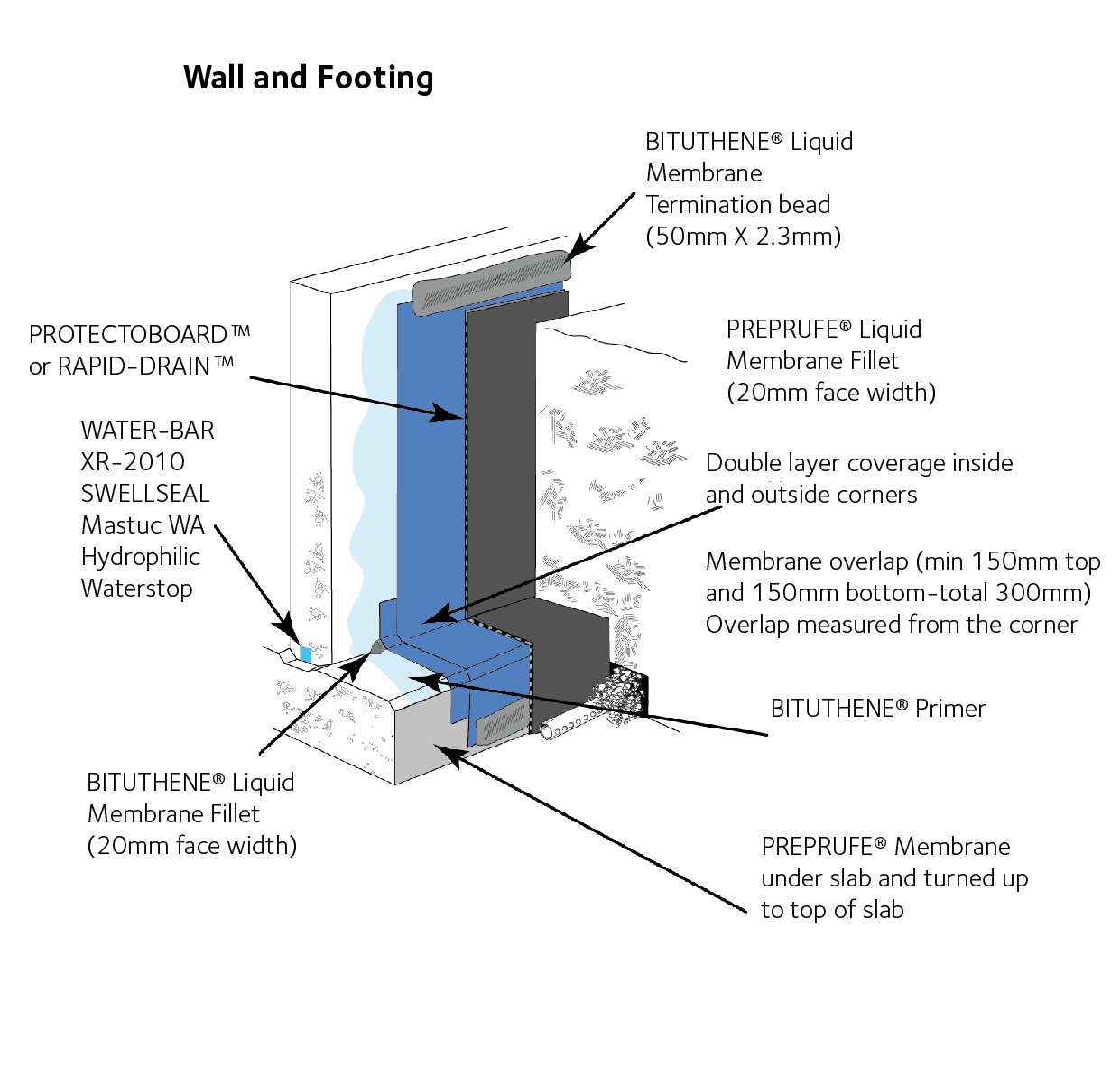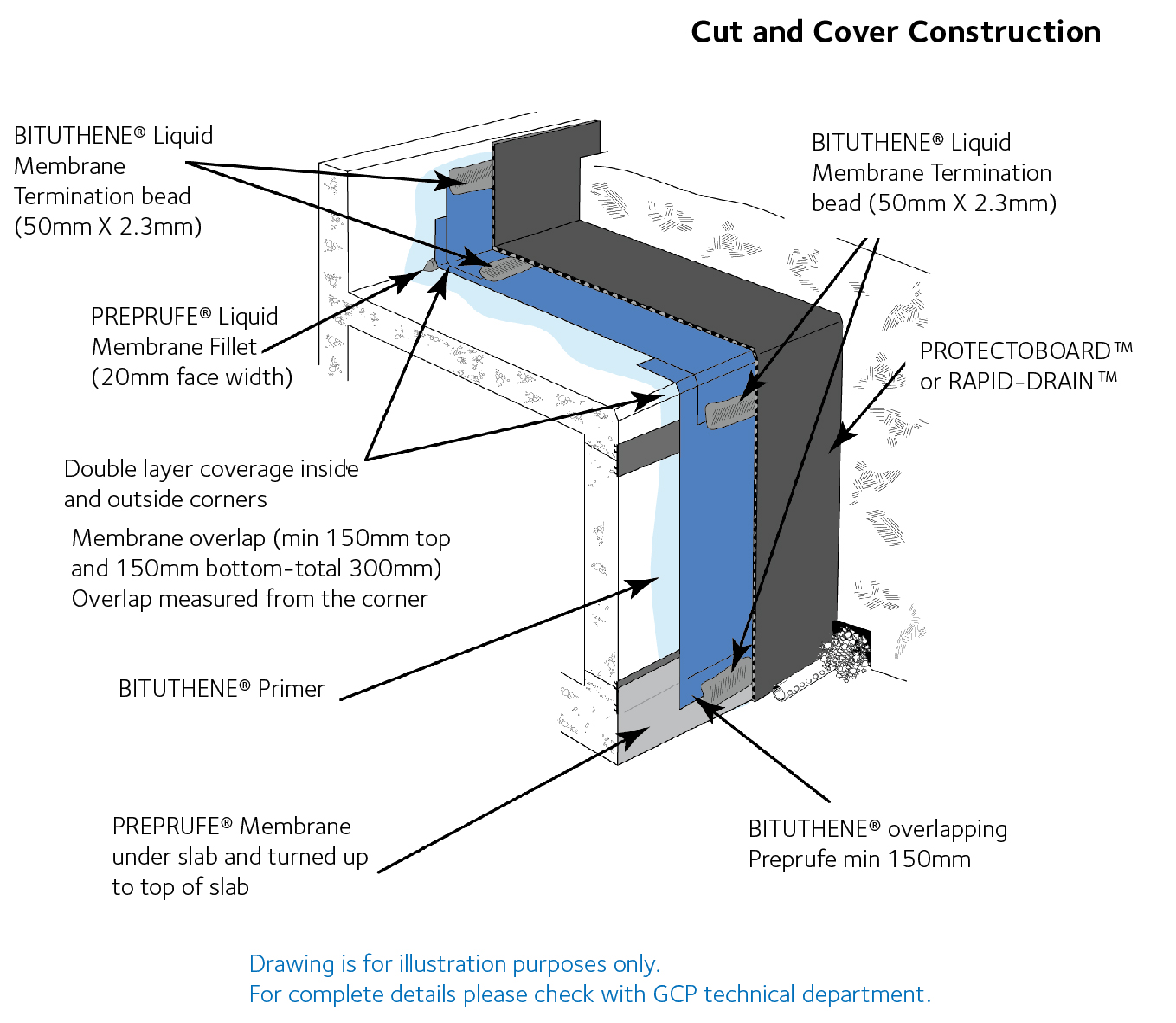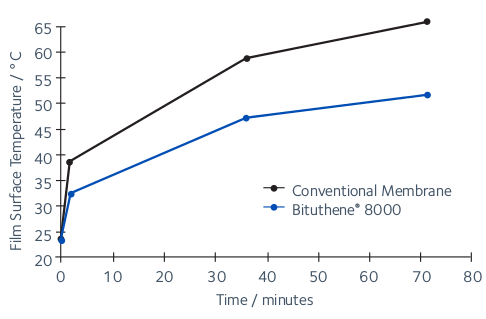BITUTHENE® 8000
Advanced, self-adhesive, solar reflective, water, moisture and gas proofing membrane for above and below ground waterproofing applications
Product Description
BITUTHENE® 8000 Waterproofing Membrane combines the proven BITUTHENE adhesive technology with a unique, grey-coloured carrier film to provide superior performance and easier installation. BITUTHENE 8000 Waterproofing Membrane has been tested to withstand more than 70m head of water and is over 90 times more methane resistant than the BRE minimum recommendation.
The membrane is printed with the Bituthene logo to aid identification plus an overlap line at each edge to ensure 50mm minimum lap. Bituthene 8000 Waterproofing Membrane is extremely tough but any accidental damage which would otherwise be missed, is made visible by the black compound showing through the light grey film. This can be simply repaired with a patch of Bituthene 8000 Waterproofing Membrane.
Product Advantages
- Water and moisture proof — Provides protection for Grades 2, 3 and 4, BS 8102:1990.
- Gas-resistant — Protects against methane and radon.
- Non-metalised film — Not vulnerable to chemical attack; eliminates overbanding of laps associated with aluminum-based membranes.
- Cold applied — Self-adhesive overlaps ensure continuity.
- Wide application “window” reduces delays — Application temperature ranges from -5ºC to +35ºC (Hot Climate grade is up to 55ºC) and damp surface tolerant.
- Solar reflective surface — Over 20% reduction of solar heat absorption while membrane is temporarily exposed.
- Facilitates quality assured installation — Printed overlap line ensures minimum laps; light colour highlights accidental damage for simple patch repairs.
- Dimension stability — Wrinkle-resistant.
- Chemical resistance — Provides effective external protection against aggressive environment.
- System compatibility— Can be combined with PREPRUFE® pre-applied membranes, BITUTHENE® Liquid Membrane, and HYDRODUCT® drainage composites for system solutions.
Storage
- Observe one-year shelf life and use on a first in, first out basis.
- Store in dry conditions between 5°C and 32°C.
- Store off ground, under tarps or otherwise protected from rain and ground moisture.
Installation
Temperature
Apply BITUTHENE 8000 Membrane only in dry weather and when air and surface temperatures and at 5°C to 35°C.
Surface Preparation
Surfaces must be structurally sound and free of voids, spalled areas, loose aggregate and sharp protrusions. Remove contaminants such as grease, oil and wax from exposed surfaces. Remove dust, dirt, loose stone and debris. Concrete must be properly cured (minimum 7-days for normal structural concrete and 14-days for lightweight structural concrete). For horizontal applications, double the above cure times of concrete if placed over non-vented decks. Certain conditions may require longer dry times, such as unusually wet weather or late removal of forms. Use form release agents which will not transfer to the concrete. Remove forms as soon as possible from below horizontal slabs to prevent entrapment of excess moisture. Excess moisture may lead to blistering of the membrane. Cure concrete with clear, resin-based curing compounds which do not contain oil, wax or pigment. See Technical Letter TL-0005 Curing Compounds and Form Release Agents. Do not apply any products to frozen concrete. Repair defects such as spalled or poorly consolidated areas. Remove sharp protrusions and form match lines.
Priming
Horizontal surfaces: For substrates with moisture content below 5.0%, prime the horizontal surfaces with BITUTHENE Solvent Primer when substrates and ambient temperatures are between 5~35°C. Apply primer by brush or roller at a rate of 6-8 m2/ litre depending on the porosity of the surface, and allow to dry completely before the application of BITUTHENE 8000. Porous substrates may require more than one coat. Do not apply any primer directly onto any BITUTHENE Membranes.
Vertical surfaces: For substrates with moisture content below 5.0%, prime the vertical surfaces with BITUTHENE Solvent Primer when substrates and ambient temperatures are between 10~35°C. Apply primer by brush or roller at a rate of 6-8 m2 / litre depending on the porosity of the surface, and allow to dry completely before the application of BITUTHENE 8000. Porous substrates may require more than one coat. Do not apply any primer directly onto any BITUTHENE Membranes. During cold weather, apply Bituthene Solvent Primer Vertical when substrates and ambient temperatures are between 5~10°C to dry (<5.0% moisture content) structural concrete and masonry surfaces. Refer to technical datasheet of Bituthene Solvent primer Vertical for details
For damp or green concrete with moisture content between 5~10%, apply Bituthene Primer Type C when substrates and ambient temperatures are between 5~35°C. Refer to technical datasheet of Bituthene Primer Type C for details.
Application on Horizontal Surfaces
(Note: PREPRUFE pre-applied membranes are recommended for below slab or for any application where the membrane is applied before concreting. See PREPRUFE Waterproofing Membrane product information sheets.)
All horizontal surfaces to receive BITUTHENE 8000 membrane should be sloped to drain at least 11 mm/m. When a minimum slope of 11 mm/m cannot be achieved, two layers of BITUTHENE 8000 membranes may be an option.
Apply membrane from the low point to the high point so that laps shed water. Overlap all seams at least 50 mm. Stagger all end laps. Roll the entire membrane firmly and completely as soon as possible. Use a linoleum roller or standard water-filled garden roller less than 760 mm wide, weighing a minimum of 34 kg when filled. Cover the face of the roller with a resilient material such as a 13 mm plastic foam or two wraps of indoor-outdoor carpet to allow the membrane to fully contact the primed substrate. Seal all T-joints and membrane terminations with BITUTHENE Liquid Membrane by the end of the day.
Application on Vertical Surfaces
Apply membrane in lengths up to 2.5 m. Overlap all seams at least 50 mm. On higher walls apply membrane in two or more sections with the upper overlapping the lower by at least 50 mm. Roll all membrane with a hand roller. Terminate the membrane at grade level. Press the membrane firmly to the wall with the butt end of a hardwood tool such as a hammer handle or secure into a reglet. Failure to use heavy pressure at terminations can result in a poor seal. All top of wall terminations must be sealed with BITUTHENE Liquid Membrane. A termination bar may be used to ensure a tight seal. At the end of each working day, if the wall has been only partially covered, apply a maximum 6mm bead of BITUTHENE Liquid Membrane along the exposed edges of the membrane at its temporary terminations to prevent vertical drainage of precipitation undermining the membrane adhesion. Terminate the membrane at the base of the wall if the bottom of the interior floor slab is at least 150 mm above the footing. Otherwise, use appropriate inside corner detail where the wall and footing meet. A 3 mm x 25 mm aluminum termination bar aligned.
Physical Property
| PROPERTY | TYPICAL VALUE | TEST METHOD |
|---|---|---|
| Colour | Light grey | |
| Thickness* | 1.5mm | ASTM D3767 Procedure A |
| Hydrostatic Head Resistance | > 70m (note 1) | ASTM D5385 |
| Application temperature | > -5ºC | |
| Low temperature flexibility | Unaffected/Pass | ASTM D1970 |
| Water Vapour Rransmission Rate | 0.023 perm | ASTM E96 |
| Elongation, ultimate failure of rubberized asphalt | 100% minimum | ASTM D412 |
| Crack cycling at -32°C,100 cycles | Unaffected | ASTM C836 |
| Peel strength | 945 N/m | ASTM D9033 |
| Methane Permeability | 3.89mL m2/day (note 2) | Queen Mary & Westfield College, University of London |
| Tensile Strength at 23oC | 482 psi | ASTM D412 modified# |
| Puncture Resistance | 280N | ASTM E154 |
| Radon Transmission | 6 x 10 m.s-1 | S. P. Institute, Sweden |
| VOC permeance | Not Detectable / Membrane, Seam | ASTM F 739 / Open loop |
*Nominal thickness refers to the thickness of the membrane without release liner.
#Run at a rate of 50mm / min.
Note 1: Test carried out on an overlap crossing a post formed
Note 2: Typical value for BRE recommended minimum standard (BRE Report 212) is 360mL / m2 / day.
Note 3: peel strength on primed concrete
Typical test values may represent average values from samples tested. Test methods noted may be modified.
Bituthene 8000 Waterproofing Membrane complies with the relevant section of the following national standards: BS 8102:1990. Building Regulations (England and Wales) 1991 (amended 1994) clause C4. Building Regulations (Northern Ireland) 1994 (amended 1995) clause B2. Building Standard (Scotland) Regulations 1990. Regulation B2.1, G2.6.
Membrane Repairs
Patch tears and inadequately lapped seams with the same membrane as used on the surrounding surface. Clean the in place membrane with a damp cloth and completely dry. Slit fishmouths and repair with a patch extending 50 mm in all directions from the slit and seal edges of the patch with BITUTHENE Liquid Membrane. Inspect the membrane thoroughly before covering and make all repairs prior to testing, covering or backfilling.
Flood Testing (Horizontal Surfaces Only)
Flood test all horizontal applications with a minimum 50 mm head of water for 24-hours. Mark any leaks and repair when the membrane is dry. Before flood testing, be sure the structure will withstand the dead load of the water. For sloped decks, it may be necessary to segment the flood test to avoid deep water near drains.
Conduct the flood test 24-hours after completing the application of BITUTHENE waterproofing system. Immediately after flood test is completed, and all necessary repairs made, install drainage composite to protect the BITUTHENE membrane from traffic and other trades.
As an alternate to flood testing, appropriate electronic leak detection may be used to check the integrity of the system.
Drainage
HYDRODUCT® / Rapid-Drain drainage composites are recommended for both active drainage and protection of the membrane. See HYDRODUCT® / Rapid-Drain product data sheet on your local GCP website.
Insulation
Always apply BITUTHENE Membrane directly to primed or conditioned structural substrates. Insulation, if used, must be applied over the membrane. Do not apply BITUTHENE membranes over insulation or lightweight insulating concrete.
Protection of Membrane
Protect BITUTHENE Membranes to avoid damage from other trades, construction materials or backfill. At temperatures above 25°C to avoid potential formation of blisters place protection immediately.
Following the application, care should be taken to prevent damage by following trades by using PROTECTBOARD™ spot bonded with BITUSTIK™ Tape Super or a 25mm screed as horizontal protection. Vertical faces to be protected against damage from backfilling and reinforcement by using PROTECTOBOARD™ spot bonded with BITUSTIK™ Tape Super.
Placing Steel
On horizontal applications when placing steel over properly protected membrane, use concrete bar supports (dobies) or chairs on pizza trays, to prevent damage from sharp edges. Use special care when using wire mesh, especially if the mesh is curled.
Backfill
Place backfill as soon as possible. (See Protection of Membrane section above) Use care during backfill operation to avoid damage to the waterproofing system. Follow generally accepted practices for backfilling and compaction. Backfill should be added and compacted in 150 mm to 300 mm lifts.
Comparsion of solar heat gain over time on exposed membrane samples.
Technical Services
For assistance with working drawings for projects and additional technical advice, please contact your local GCP representative.
Applications
It can be used horizontally or vertically to protect basements and other critical sub-structures from the effects of water, damp and gas penetration. Also, Bituthene 8000 Waterproofing Membrane is suitable for flat decks such as inverted roofs, elevated or grade level podiums or plaza decks as the reduced solar gain is an advantage.
Ancillary Products
- BITUTHENE Solvent Primer - bitumen-based primer used to prime dry structural concrete and masonry surfaces, with moisture content below 5.0%.
- BITUTHENE Solvent Primer Vertical - bitumen-based high-tack primer for vertical applications in code weather, to dry (< 5.0% moisture content) structural concrete and masonry surfaces.
- BITUTHENE Primer Type C - water borne bitumen-based primer, used to prime damp or green concrete, with moisture content below 10.0%
- BITUTHENE Liquid Membrane - two component, elastomeric, liquid applied detailing compound.
- PROTECTOBOARD™ /HYDRODUCT - membrane protection/® drainage system.
- BITUSTIK™ Tape Super - double sided adhesive tape.
- Water-Bar /Swellseal ® waterstops – for construction and expansion joints.
- The most current Data Sheets for most system components are available at gcpat.com. For more information on any system or ancillary component contact your local GCP technical service advisor.
Supply
| Thickness (Nominal) | 1.5mm |
| Pack Size | 1.0m x 20m |
| Roll Area | 20sqm |
| Gross Weight | 39kg |
| Min Edge / End Laps | 50mm |
Limitation of Use
Bituthene 8000 Waterproofing Membrane is not intended for permanent exposure. Exposed areas of membrane at upstands, etc., should be covered with similar flashing.
- Information contained in this document does not cover all possible application scenarios or imply product suitability for an application. Please contact your local GCP representative or the GCP Technical Department for further information.
- BITUTHENE Membranes are designed where in-service temperatures will not exceed 54°C.
- Do not use BITUTHENE Mastic to terminate BITUTHENE Membranes to PREPRUFE pre-applied waterproofing membrane systems. Terminations to PREPRUFE membranes should only be done with BITUTHENE Liquid Membrane.
- Do not apply BITUTHENE Membranes over insulation or lightweight insulating concrete.
Health and Safety
Refer to relevant Material Safety Data Sheet.
Quality Assurance
GCP Applied Technologies is certified to ISO 9001 : 2008 by TUV SUD PSB Pte Ltd.
gcpat.com.au | Australia customer service: 1800 855 525
We hope the information here will be helpful. It is based on data and knowledge considered to be true and accurate, and is offered for consideration, investigation and verification by the user, but we do not warrant the results to be obtained. Please read all statements, recommendations, and suggestions in conjunction with our conditions of sale, which apply to all goods supplied by us. No statement, recommendation, or suggestion is intended for any use that would infringe any patent, copyright, or other third party right.
Bitustik, Bituthene, Preprufe, Hydroduct, Servidrain, and Servipak are trademarks, which may be registered in the United States and/or other countries, of GCP Applied Technologies, Inc. This trademark list has been compiled using available published information as of the publication date and may not accurately reflect current trademark ownership or status.
© Copyright 2024 GCP Applied Technologies, Inc. All rights reserved.
GCP Applied Technologies Inc., 2325 Lakeview Parkway, Alpharetta, GA 30009, USA GCP Australia Pty. Ltd., 14 Colebard Street West, Archerfield, Brisbane, Queensland 4108, Australia This document is only current as of the last updated date stated below and is valid only for use in Australia. It is important that you always refer to the currently available information at the URL below to provide the most current product information at the time of use. Additional literature such as Contractor Manuals, Technical Bulletins, Detail Drawings and detailing recommendations and other relevant documents are also available on www.gcpat.com.au. Information found on other websites must not be relied upon, as they may not be up-to-date or applicable to the conditions in your location and we do not accept any responsibility for their content. If there are any conflicts or if you need more information, please contact GCP Customer Service.
Last Updated: 2025-11-20
https://gcpat.com.au/en-gb/solutions/products/bituthene-post-applied-waterproofing/bituthene-8000


